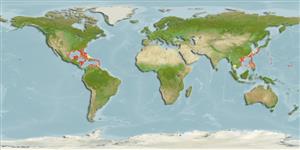Common names from other countries
Environment: milieu / climate zone / depth range / distribution range
Écologie
marin récifal; non migrateur; profondeur 5 - 80 m (Ref. 9626), usually 5 - 30 m (Ref. 9626). Subtropical; 35°N - 10°N
Western Atlantic: Bermuda and Florida, USA to French Guiana, including the Gulf of Mexico and the Caribbean Sea.
Taille / Poids / Âge
Maturity: Lm ? range ? - ? cm
Max length : 8.0 cm TL mâle / non sexé; (Ref. 9710)
Épines dorsales (Total): 14 - 15; Rayons mous dorsaux (Total): 15-16; Épines anales 3; Rayons mous anaux: 17. Deep blue, the head and chest orange-yellow; a narrow blue ring around eye; a small dark blue smudge just behind corner of mouth; pectoral fins pale yellowish; other fins deep blue with pale blue margins (Ref. 13442).
Normally occurs in rubble areas. Feeds on various types of algae. Oviparous (Ref. 205), monogamous (Ref. 52884). Retreats into holes when frightened (Ref. 9710). Has been reared in captivity (Ref. 35408).
Life cycle and mating behavior
Maturité | Reproduction | Frai | Œufs | Fécondité | Larves
Oviparous, distinct pairing (Ref. 240). Monogamous mating is observed as both facultative and social (Ref. 52884).
Allen, G.R., 1985. Butterfly and angelfishes of the world. Vol. 2. 3rd edit. in English. Mergus Publishers, Melle, Germany. (Ref. 4858)
Statut dans la liste rouge de l'IUCN (Ref. 130435)
CITES (Ref. 128078)
Not Evaluated
Menace pour l'homme
Harmless
Utilisations par l'homme
Aquarium: Commercial
Plus d'informations
RéférencesAquacultureProfil d'aquacultureSouchesGénétiqueElectrophoresesHéritabilitéPathologiesTraitementMass conversion
Outils
Articles particuliers
Télécharger en XML
Sources Internet
Estimates based on models
Preferred temperature (Ref.
115969): 23.5 - 28.1, mean 26.1 (based on 324 cells).
Phylogenetic diversity index (Ref.
82804): PD
50 = 0.5000 [Uniqueness, from 0.5 = low to 2.0 = high].
Bayesian length-weight: a=0.03090 (0.01359 - 0.07026), b=2.89 (2.70 - 3.08), in cm Total Length, based on LWR estimates for this (Sub)family-body shape (Ref.
93245).
Niveau trophique (Ref.
69278): 2.0 ±0.0 se; based on diet studies.
Résilience (Ref.
120179): Haut, temps minimum de doublement de population inférieur à 15 mois (Preliminary K or Fecundity.).
Fishing Vulnerability (Ref.
59153): Low vulnerability (10 of 100).
